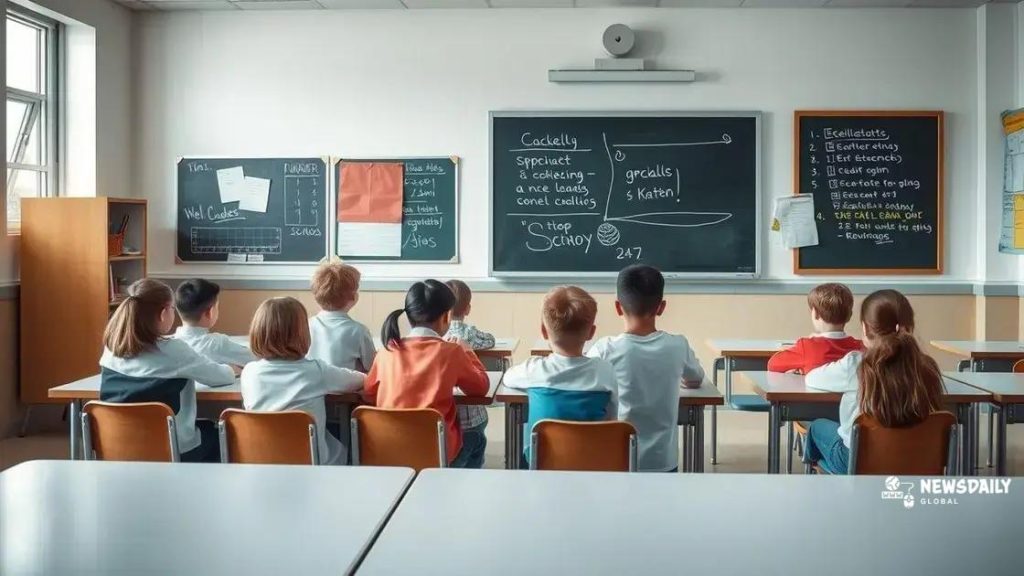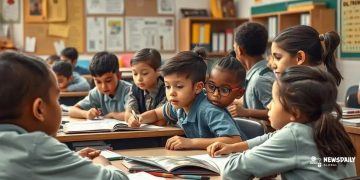Trump’s education agenda returns with controversial proposals

Trump’s education agenda returns with controversial proposals that emphasize school choice, funding shifts from public to private education, and changes to curricula, raising concerns about the impact on educational equity and quality for students.
Trump’s education agenda returns with a slew of controversial proposals that promise to shake up the educational landscape. How will these changes affect students and schools across the nation? Let’s dive into the key elements and the ensuing debate.
Key components of Trump’s education proposals
The key components of Trump’s education proposals are designed to reshape the educational landscape. With a focus on increasing school choice and promoting alternatives to traditional public schools, these proposals are stirring significant debate.
School Choice Expansion
One of the main features is the expansion of school choice. This aims to give parents and students more options beyond their assigned public schools.
- Increased funding for charter schools.
- Tax credits for private school tuition.
- Vouchers for low-income families.
Curriculum Changes
Another critical area is the proposed changes in curriculum standards. Trump’s agenda emphasizes a move towards a more patriotic education system, promoting American history’s positive aspects.
This change aims to foster a sense of national pride among students. Additionally, there are plans to enhance vocational training, providing students with practical skills for the job market.
Such initiatives could equip students better for future careers. However, opinions are divided on how these changes might impact educational quality and inclusivity.
Increased Funding for Private Education
Proposals also include increased funding for private education initiatives. The goal here is to enhance educational opportunities outside public systems, further diversifying the educational environment.
- Grants for private schools to improve facilities.
- Programs that support homeschooling resources.
- Financial aid for families seeking private education.
The impact of these changes may vary widely across different communities, with some benefiting significantly while others may struggle. As these proposals unfold, it is crucial to monitor how they affect students’ educational outcomes and overall well-being.
Impact on public education funding
The impact on public education funding due to Trump’s proposals is a key concern for many stakeholders. Changes in funding allocations could significantly alter how public schools operate.
Reduction in Funding for Public Schools
One potential effect of Trump’s education agenda is a reduction in funding for traditional public schools. As more resources are directed towards charter and private schools, public institutions may face tighter budgets.
- Possible layoffs of teachers and staff.
- Reduction in programs like art and music.
- Increased class sizes.
Shift to Performance-Based Funding
Another aspect is the shift towards performance-based funding. Schools might receive resources based on their students’ academic outcomes rather than their needs.
This could create disparities among schools, as those in less affluent areas may struggle to keep up with better-funded schools. The incentive to focus solely on standardized test scores could also lead to a narrow curriculum.
With this funding strategy, schools might prioritize testing over holistic education, potentially neglecting important skills that aren’t tested.
Potential for Increased Community Involvement
On a positive note, changes in funding could lead to increased community involvement. With schools seeking alternative funding sources, community partnerships may become more common.
- Local businesses may support schools through sponsorships.
- Parents and community members could create fundraising initiatives.
- Volunteers might play a bigger role in classroom support.
While these changes could enhance community ties, they also raise questions about equitable access to educational resources. If public funding diminishes, can communities fill the gap equally for all students?
Controversies surrounding the proposed changes

The controversies surrounding the proposed changes in Trump’s education agenda have sparked significant debate among educators, parents, and policymakers. Concerns arise regarding the impact of these changes on students and the overall educational system.
Debate on School Choice
One major controversy is related to the push for expanded school choice. Advocates argue that it provides families with options, allowing students to find schools that better meet their needs.
- Supporters believe choice enhances competition and improves quality.
- Critics claim it drains resources from public schools.
- There are worries about accountability and oversight of private institutions.
Equity and Access Issues
Another point of contention is the potential for increased inequity in education. As funding shifts toward charter and private schools, students in low-income areas may have fewer opportunities.
Concerns include the widening achievement gap and the ability of public schools to support vulnerable populations. Parents fear that less funding will lead to inadequate resources for essential programs. This raises questions about whether every child will receive a fair quality education.
Curriculum Controversies
Proposed changes to educational curricula have also ignited heated discussions. The emphasis on a more patriotic view of history may alienate some educators and students.
- Some believe it undermines critical thinking.
- Others argue that it promotes a skewed version of American history.
- The focus on testing outcomes may limit broader educational goals.
These controversies highlight the complex dynamics at play in the education system, as communities navigate the implications of these proposed changes.
Reactions from educators and parents
The reactions from educators and parents to Trump’s education proposals are varied and often passionate. As these changes are discussed, many worry about their potential impact on schools and their children.
Educators’ Concerns
Many teachers express concern about how these proposals may affect their classrooms. They fear that cuts to public school funding will lead to fewer resources for students.
- Class sizes may increase, making it harder to provide individual attention.
- Essential programs, like art and physical education, could face elimination.
- Stress on standardized testing may take away from creative learning.
Parental Perspectives
Parents have varied opinions based on their experiences and beliefs about education. Some support the idea of school choice, believing it allows parents to choose the best fit for their children.
However, many parents feel concerned that these changes could worsen educational inequality. They worry that not all families will have equal access to better schools or educational resources.
Discussions with parents highlight the desire for quality education that serves every child, rather than prioritizing certain institutions over others. They want assurance that public schools will remain adequately funded and effective.
Community Action
In response to these proposals, many educators and parents are taking action. They are participating in community meetings and organizing to voice their concerns.
- Petitions urging policymakers to consider public school funding.
- Parent-teacher associations discussing the implications of these changes.
- Workshops educating the community about the impacts of revised policies.
This engagement illustrates a strong community commitment to preserving quality education for all students, demonstrating a collective voice against changes perceived as harmful.
Future implications for students and schools
The future implications for students and schools resulting from Trump’s education proposals could reshape the landscape of American education for years to come. These changes may have lasting effects on how education is delivered and perceived.
Impact on Educational Quality
As funding priorities shift, the quality of education may vary significantly between different types of schools. Public schools may struggle to maintain their programs amidst budget cuts while charter and private schools receive increased funding and support.
- Potential decline in educational resources for public schooling.
- Difficulty in attracting and retaining qualified teachers.
- Increased competition may drive improvement in some public schools.
Long-term Outcomes for Students
The experience that students have during their school years will shape their future opportunities. Access to quality education can open doors for higher education and better job prospects.
Conversely, students attending underfunded schools may face challenges that limit their choices later on. The disparity in educational quality could lead to larger societal issues, including economic inequality.
Community and Parental Involvement
As families navigate these changes, involvement in education may increase. Parents and community members might become more engaged in advocating for improvements in their local schools.
- Stronger partnerships between schools and local organizations.
- Increased participation in school board meetings and community discussions.
- Movements to ensure equitable education for all students.
This potential for increased activism signals a shift where communities take more responsibility for the education system. The future will likely depend on how well schools and families collaborate to ensure all students receive a fair chance at quality education.
FAQ – Questions about Trump’s Education Agenda
What are the key changes proposed in Trump’s education agenda?
The agenda includes expanded school choice, changes to curricula, and shifts in funding that prioritize charter and private schools over traditional public schools.
How might these proposals impact public school funding?
Public schools may face reduced funding as resources are redirected to charter and private education, potentially leading to larger class sizes and fewer programs.
What concerns do educators have regarding these changes?
Educators fear that decreased funding could hinder their ability to provide quality education and may result in layoffs or cuts to essential programs.
How can parents and communities get involved?
Parents and communities can engage by attending school board meetings, organizing discussions, and advocating for equitable funding and resources in local schools.






